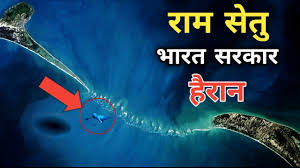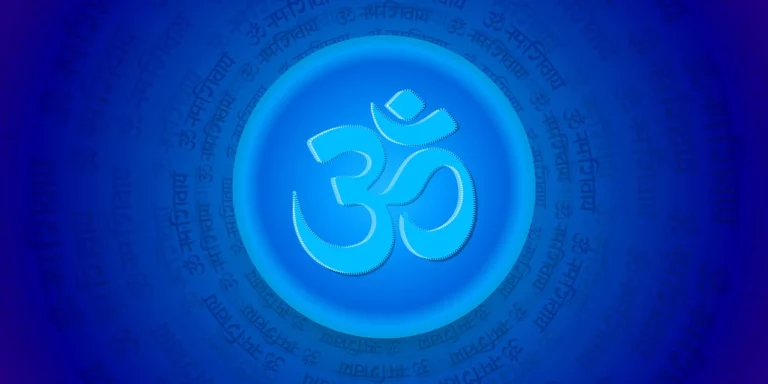मम कृत सेतु जो दरसनु करिही।
सो बिनु श्रम भवसागर तरिही।।
प्रभु श्रीराम कहते हैं, जो मेरे बनाए सेतु का दर्शन करेगा, वह बिना ही परिश्रम संसार रूपी समुद्र से तर जाएगा। कभी आपके साथ ऐसा हुआ है कि आपने कोई पत्थर पानी में फेंका और वह डूबा नहीं, बल्कि पानी की सतह पर तैरता चला गया हो?
शायद नहीं, क्योंकि पत्थर का एक पर्याप्त वजन पानी को चीरते हुए खुद को उसमें डुबो ही लेता है। फिर आश्चर्य की बात है कि सदियों पहले श्रीराम की वानर सेना द्वारा बनाए गए रामसेतु पुल के पत्थर पानी में डालते ही डूबे क्यों नहीं?
वही रामसेतु जिसे अंतरराष्ट्रीय स्तर पर ‘एडेम्स ब्रिज’ के नाम से जाना जाता है। हिन्दू धार्मिक ग्रंथ रामायण के अनुसार यह एक ऐसा पुल है, जिसे भगवान विष्णु के सातवें एवं हिन्दू धर्म में विष्णु के सबसे ज्यादा प्रसिद्ध रहे अवतार श्रीराम की वानर सेना द्वारा भारत के दक्षिणी भाग रामेश्वरम पर बनाया गया था, जिसका दूसरा किनारा वास्तव में श्रीलंका के मन्नार तक जाकर जुड़ता है।
ऐसी मान्यता है कि इस पुल को बनाने के लिए जिन पत्थरों का प्रयोग किया गया था वह पत्थर पानी में फेंकने के बाद समुद्र में नहीं डूबे। बल्कि पानी की सतह पर ही तैरते रहे। ऐसा क्या कारण था कि यह पत्थर पानी में नहीं डूबे? कुछ लोग इसे धार्मिक महत्व देते हुए ईश्वर का चमत्कार मानते हैं लेकिन विज्ञान इसके पीछे क्या तर्क देता है यह बिल्कुल विपरीत है।
लेकिन इससे ऊपर एक बड़ा प्रश्न सेकुलरों का यह है कि ‘क्या सच में रामसेतु नामक कोई पुल था।’ क्या सच में इसे हिन्दू धर्म के भगवान श्रीराम ने बनवाया था? और यदि बनवाया था तो अचानक यह पुल कहां गया।
धार्मिक मान्यता अनुसार जब असुर सम्राट रावण माता सीता का हरण कर उन्हें अपने साथ लंका ले गया था, तब श्रीराम ने वानरों की सहायता से समुद्र के बीचो-बीच एक पुल का निर्माण किया था। यही आगे चलकर रामसेतु कहलाया था। कहते हैं कि यह विशाल पुल वानर सेना द्वारा केवल ५ दिनों में ही तैयार कर लिया गया था। कहते हैं कि निर्माण पूर्ण होने के बाद इस पुल की लम्बाई ३० किलोमीटर और चौड़ाई ३ किलोमीटर थी।
आश्चर्य की बात है कि मीलों का अंतर रखने वाले दो देशों के बीचो-बीच उपस्थित इस समुद्र को लांघने के लिए मात्र पांच दिनों में कैसे वानर सेना ने एक पुल बना डाला। इसे विस्तार से समझने के लिए महर्षि वाल्मीकि द्वारा रची गई ‘रामायण’ में रामसेतु के निर्माण का वर्णन किया गया है।
रामायण ग्रंथ के अनुसार जब लंकापति राजा रावण, श्रीराम की पत्नी सीता का हरण कर उन्हें लंका ले गया था, तब भगवान श्रीराम ने अपनी पत्नी की खोज आरंभ की। जटायू से उन्हें यह पता लगा कि उनकी पत्नी को एक ऐसा राक्षस राजा ले गया है, जो मीलों दूर एक बड़े समुद्र को पारकर दूसरे छोर पर लंका में रहता है।
अब चिंतित श्रीराम यह सोचने लगे कि आखिरकार वे किस प्रकार से अपनी पत्नी को लंका में खोजेंगे। तब पवनपुत्र हनुमानजी ने अपनी दैविक शक्तियों का प्रयोग किया और उड़ान भरकर लंका की ओर निकल गए माता सीता को खोजने के लिए।
लंका पहुंचकर रावण की कैद में हनुमानजी ने सीताजी को खोज तो निकाला, लेकिन वे उन्हें वापस ना लेकर आए। क्योंकि उन्होंने देखा कि केवल माता सीता ही नहीं, बल्कि उनके साथ एक बड़ी संख्या में निर्दोष लोगों को रावण ने अपना बंदी बनाया हुआ है।
तब श्रीराम ने निर्णय किया कि वे स्वयं अपनी सेना के साथ लंका जाकर ही सबको रावण की कैद से छुड़ाएंगे। लेकिन यह सब कैसे होगा, यह एक बड़ा सवाल था। क्योंकि निश्चय तो था लेकिन रास्ते में था एक विशाल समुद्र जिसे पार करने का कोई साधन नहीं हो पा रहा था।
एक पौराणिक कथा के अनुसार ऐसा माना जाता है कि अपनी कठिनाई का हल निकालने के लिए श्रीराम द्वारा समुद्र देवता की पूजा आरंभ की गई। लेकिन जब कई दिनों के बाद भी समुद्र देवता प्रकट नहीं हुए तब क्रोध में आकर श्रीराम ने समुद्र को सुखा देने के उद्देश्य से अपना धनुष-बाण उठा लिया।
उनके इस कदम से समुद्र के प्राण सूखने लगे। तभी भयभीत होकर समुद्र देवता प्रकट हुए और बोले, “श्रीराम! आप अपनी वानर सेना की मदद से मेरे ऊपर पत्थरों का एक पुल बनाएं। मैं इन सभी पत्थरों का वजन सम्भाल लूंगा। आपकी सेना में नल एवं नील नामक दो वानर हैं, जो सर्वश्रेष्ठ हैं।“
“नल, जो कि भगवान विश्वकर्मा के पुत्र हैं उन्हें अपने पिता द्वारा वरदान हासिल है। उनकी सहायता से आप एक कठोर पुल का निर्माण कराएं। यह पुल आपकी सारी सेना का भार संभाल लेगा और आपको लंका ले जाने में सफल होगा”, ऐसा कहते हुए समुद्र देव ने श्रीराम से पुल बनाने का विनम्र अनुरोध किया।
अगले ही पल नल तथा नील की मदद से पूरी वानर सेना अनेकों प्रकार की योजनाएं बनाने में सफल हुई। अंत में योजनाओं का चुनाव करते हुए पुल बनाने का सामान एकत्रित किया गया। पूरी वानर सेना आसपास से पत्थर, पेड़ के तने, मोटी शाखाएं एवं बड़े पत्ते तथा झाड़ लाने में सफल हुई।
अंत में नल तथा नील की देखरेख तथा पूर्ण वैज्ञानिक योजनाओं के आधार पर एक विशाल पुल तैयार किया गया। वैज्ञानिकों का मानना है कि नल तथा नील शायद जानते थे कि कौन सा पत्थर किस प्रकार से रखने से पानी में डूबेगा नहीं तथा दूसरे पत्थरों का सहारा भी बनेगा।
वानरों द्वारा बनाए गए इस पुल का एक हिस्सा भारत के रामेश्वरम से शुरू होकर लंका के मन्नार द्वीप से जुड़ता था। इस पुल द्वारा अपनी सेना के साथ श्रीराम लंका पहुंचे और वहां असुर सम्राट रावण के साथ भीषण युद्ध किया। अंत में रावण को हराकर वे अपनी पत्नी सीता और उन कैदियों को छुड़ाने में सफल हुए जो वर्षों से रावण की कैद में बंधे हुए थे।
श्रीराम तथा रावण के बीच हुआ यह युद्ध हिन्दू धर्म के इतिहास में सबसे महत्वपूर्ण युद्ध रहा, क्योंकि इस युद्ध ने लोगों को समझाया कि अधर्म पर हमेशा धर्म की ही जीत होती है। लेकिन आज का आधुनिक युग विभिन्न मान्यताओं नहीं बल्कि तथ्यों को अपना आधार मानता है।
इसलिए इतने सालों के शोध के बाद वैज्ञानिकों ने रामसेतु पुल में उपयोग हुए पत्थरों का अस्तित्व खोज निकाला है। विज्ञान का मानना है कि रामसेतु पुल को बनाने के लिए जिन पत्थरों का उपयोग हुआ था वे कुछ विशेष प्रकार के पत्थर हैं, जिन्हें ‘प्यूमाइस स्टोन’ कहा जाता है।
वास्तव में यह पत्थर ज्वालामुखी के लावा से उत्पन्न होते हैं। जब लावा की गर्मी वातावरण की कम गर्म हवा या फिर पानी से मिलती है तो वे खुद को कुछ कणों में बदल देती है। कई बार यह कण एक बड़े पत्थर को निर्मित करते हैं। वैज्ञानिकों का मानना है कि जब ज्वालामुखी का गर्म लावा वातावरण की ठंडी हवा से मिलता है तो हवा का संतुलन बिगड़ जाता है।
यह प्रक्रिया एक ऐसे पत्थर को जन्म देती है जिसमें कई सारे छिद्र होते हैं। छिद्रों की वजह से यह पत्थर एक स्पॉंजी यानी कि खंखरा आकार ले लेता है जिस कारण इनका वजन भी सामान्य पत्थरों से काफी कम होता है। इस खास पत्थर के छिद्रों में हवा भरी रहती है। यही कारण है कि यह पत्थर पानी में जल्दी डूबता नहीं है क्योंकि हवा इसे ऊपर ही रखती है।
लेकिन कुछ समय के बाद जब धीरे-धीरे इन छिद्रों में हवा के स्थान पर पानी भर जाता है तो इनका वजन बढ़ जाता है और यह पानी में डूबने लगते हैं। यही कारण है कि रामसेतु पुल के पत्थर कुछ समय बाद समुद्र में डूब गए और उसके भूभाग पर पहुंच गए। नैशनल एरोनॉटिक्स एंड स्पेस, नासा जो कि विश्व की सबसे विख्यात वैज्ञानिक संस्था में से एक है उसके द्वारा सैटलाइट की सहायता से रामसेतु पुल को खोज निकाला गया।
इन तस्वीरों के अनुसार वास्तव में एक ऐसा पुल जरूर दिखाया गया है जो कि भारत के रामेश्वरम से शुरू होकर श्रीलंका के मन्नार द्वीप तक पहुंचता है। परन्तु किन्हीं कारणों से अपने आरंभ होने से कुछ ही दूरी पर यह समुद्र में समा गया है।
रामेश्वरम में कुछ समय पहले लोगों को समुद्र तट पर कुछ वैसे ही पत्थर मिले जिन्हें प्यूमाइस स्टोन कहा जाता है। लोगों का मानना है कि यह पत्थर समुद्र की लहरों के साथ बहकर किनारे पर आए हैं। बाद में लोगों के बीच यह मान्यता फैल गई कि हो ना हो यह वही पत्थर हैं, जिन्हें श्रीराम की वानर सेना द्वारा रामसेतु पुल बनाने के लिए प्रयोग किया गया होगा।
लेकिन वैज्ञानिकों द्वारा किए गए एक और शोध ने प्यूमाइस स्टोन के सिद्धांत को भी गलत साबित किया है। कुछ वैज्ञानिकों का मानना है कि यह सच है कि प्यूमाइस स्टोन पानी में नहीं डूबते और ऊपर तैरते हैं और यह ज्वालामुखी के लावा से बनते हैं। लेकिन उनका यह भी मानना है कि रामेश्वरम में दूर-दूर तक सदियों से कोई भी ज्वालामुखी नहीं देखा गया है।
इसके साथ ही जिस प्रकार के पत्थर रामेश्वरम के तट से प्राप्त हुए हैं, उनमें और प्यूमाइस स्टोन में काफी अंतर पाया गया है। क्योंकि उनका वजन प्राय: पाए जाने वाले प्यूमाइस स्टोन से काफी अधिक है। इसके साथ ही पाए गए पत्थरों का रंग भी आमतौर पर देखे गए प्यूमाइस स्टोन से भिन्न है। लेकिन अब यह लोगों की श्रृद्धा कहें या भावना, उनके द्वारा इन पत्थरों की विशेष रूप से पूजा की जाती है।
।। जय भगवान श्री ‘राम’ ।।
।।
Mam Krit Setu Jo Darsanu Karihi.
So without labor, the world’s ocean is gone.
Lord Shri Ram says, the one who will see the bridge made by me, he will cross the ocean of the world without any effort. Has it ever happened to you that you threw a stone into the water and it did not sink, but floated on the surface of the water?
Probably not, because a stone of sufficient weight tends to rip through the water and submerge itself in it. Then it is a matter of wonder why the stones of the Ramsetu bridge, built centuries ago by the monkey army of Shri Ram, did not sink as soon as they were thrown into the water.
The same Ramsetu which is internationally known as ‘Adams Bridge’. According to the Hindu religious text Ramayana, this is such a bridge, which was built by the monkey army of Sri Rama, the seventh and most famous incarnation of Vishnu in Hinduism, at Rameswaram in the southern part of India, the other side of which is actually in Sri Lanka. Connects till Mannar.
It is believed that the stones that were used to build this bridge did not sink in the sea after being thrown into the water. Rather kept floating on the surface of the water. What was the reason that this stone did not sink in water? Some people consider it a miracle of God giving religious importance but what science argues behind it is exactly the opposite.
But above this a big question of the seculars is that ‘Was there really a bridge called Ramsetu’. Was it really built by Lord Shri Ram of Hindu religion? And if it was built then suddenly where did this bridge go.
According to religious belief, when the Asura emperor Ravana had abducted Mother Sita and took her with him to Lanka, Shriram had built a bridge in the middle of the sea with the help of monkeys. This was later called Ramsetu. It is said that this huge bridge was built by the monkey army in just 5 days. It is said that after the completion of the construction, the length of this bridge was 30 kilometers and the width was 3 kilometers.
It is surprising that how the monkey army made a bridge in just five days to cross this sea present in the middle of two countries having a distance of miles. To understand this in detail, the construction of Ramsetu has been described in ‘Ramayana’ composed by Maharishi Valmiki.
According to the Ramayana, when Lankapati King Ravana had abducted Sri Rama’s wife Sita and took her to Lanka, then Lord Rama started searching for his wife. He learns from Jatayu that his wife has been taken away by a demon king who has crossed a great ocean miles away and lives in Lanka at the other end.
Now worried Shriram started thinking that how will he finally find his wife in Lanka. Then Pawanputra Hanumanji used his divine powers and flew towards Lanka to find Mother Sita.
After reaching Lanka, Hanumanji found Sitaji in Ravana’s captivity, but he did not bring her back. Because he saw that not only Mother Sita, but a large number of innocent people along with her were taken prisoner by Ravana.
Then Shriram decided that he himself would go to Lanka with his army and free everyone from Ravana’s captivity. But how all this would happen was a big question. Because there was determination, but there was a huge ocean on the way, which could not be crossed by any means.
According to a legend, it is believed that to find a solution to his difficulty, the worship of the sea god was started by Shriram. But when the sea god did not appear even after several days, Shriram got angry and took up his bow and arrow with the aim of drying up the sea.
With this step of his, the life of the sea started drying up. Only then the ocean god appeared in fear and said, “Shri Ram! Build a stone bridge over me with the help of your monkey army. I will bear the weight of all these stones. There are two monkeys named Nal and Neel in your army, who are the best.
“Nala, the son of Lord Vishwakarma, is blessed by his father. With their help, you build a rigid bridge. This bridge will take the weight of your entire army and will be successful in taking you to Lanka”, saying this, Samudra Dev humbly requested Shri Ram to build a bridge.
The very next moment, with the help of Nal and Neel, the entire monkey army succeeded in making various plans. In the end, while selecting the plans, the material for building the bridge was collected. The entire monkey army was successful in bringing stones, tree trunks, thick branches and big leaves and trees from the surrounding.
In the end, a huge bridge was prepared on the basis of Nal and Neel’s supervision and complete scientific plans. Scientists believe that Nal and Neel probably knew which stone would not drown in water by keeping it in which way and would also become the support of other stones.
A part of this bridge built by monkeys started from Rameshwaram in India and connected to Mannar Island in Lanka. Shri Ram reached Lanka with his army through this bridge and fought a fierce battle with the Asura emperor Ravana there. In the end, after defeating Ravana, he was able to free his wife Sita and the prisoners who were bound in Ravana’s captivity for years.
This war between Shri Ram and Ravana was the most important war in the history of Hindu religion, because this war made people understand that religion always wins over unrighteousness. But today’s modern era does not consider various beliefs but facts as its basis.
Therefore, after so many years of research, scientists have discovered the existence of the stones used in the Ramsetu bridge. Science believes that the stones used to build the Ramsetu bridge are some special type of stone, which is called ‘pumice stone’.
In fact, these stones are produced from the lava of the volcano. When the heat of the lava meets the less hot air or water of the atmosphere, they turn themselves into some particles. Sometimes these particles form a large stone. Scientists believe that when the hot lava of the volcano meets the cold air of the atmosphere, then the balance of the air gets disturbed.
This process gives rise to a stone that has many holes. Because of the holes, this stone takes a spongy shape, due to which its weight is also much less than normal stones. Air is filled in the pores of this special stone. This is the reason why this stone does not sink quickly in water because the air keeps it above.
But after some time, when water instead of air gradually fills these holes, then their weight increases and they start sinking in water. This is the reason that after some time the stones of Ramsetu bridge got drowned in the sea and reached its land. National Aeronautics and Space, NASA, which is one of the world’s most renowned scientific organization, discovered the Ramsetu bridge with the help of satellite.
According to these pictures, a bridge has actually been shown which starts from Rameswaram in India and reaches Mannar Island in Sri Lanka. But due to some reasons, it has merged into the sea at some distance from its beginning.
Sometime back in Rameshwaram people found some similar stones on the beach which are called pumice stones. People believe that these stones have come to the shore by flowing with the waves of the sea. Later, the belief spread among the people that whether it is or not, these are the same stones, which would have been used by Shriram’s monkey army to build the Ramsetu bridge.
But another research done by scientists has also proved the theory of pumice stone wrong. Some scientists believe that it is true that pumice stones do not sink in water and float on top and that they are formed from volcanic lava. But they also believe that no volcano has been seen in Rameshwaram for centuries.
Along with this, a lot of difference has been found in the type of stones obtained from the coast of Rameswaram and pumice stone. Because their weight is much more than the commonly found pumice stone. Along with this, the color of the stones found is also different from the commonly seen pumice stone. But now whether it is the faith of the people or their feelings, these stones are specially worshiped by them.
, Hail Lord Shri ‘Ram’.




















